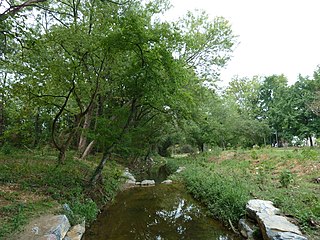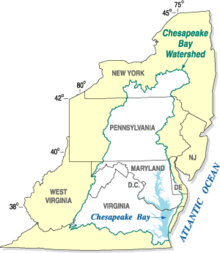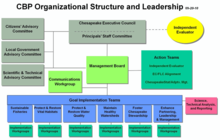
The Chesapeake Bay is the largest estuary in the United States. The Bay is located in the Mid-Atlantic region and is primarily separated from the Atlantic Ocean by the Delmarva Peninsula, including parts of the Eastern Shore of Maryland, the Eastern Shore of Virginia, and the state of Delaware. The mouth of the Bay at its southern point is located between Cape Henry and Cape Charles. With its northern portion in Maryland and the southern part in Virginia, the Chesapeake Bay is a very important feature for the ecology and economy of those two states, as well as others surrounding within its watershed. More than 150 major rivers and streams flow into the Bay's 64,299-square-mile (166,534 km2) drainage basin, which covers parts of six states and all of District of Columbia.

The Elizabeth River is a 6-mile-long (10 km) tidal estuary forming an arm of Hampton Roads harbor at the southern end of Chesapeake Bay in southeast Virginia in the United States. It is located along the southern side of the mouth of the James River, between the cities of Portsmouth, Norfolk, and Chesapeake. Forming the core of the Hampton Roads harbor, it is heavily supported by its tributaries which depend upon it.

Mattawoman Creek is a 30.0-mile-long (48.3 km) coastal-plain tributary to the tidal Potomac River with a mouth at Indian Head, Maryland, 20 miles (32 km) downstream of Washington, D.C. It comprises a 23-mile (37 km) river flowing through Prince George's and Charles counties and a 7-mile (11 km) tidal-freshwater estuary in Charles County. About three-fourths of its 94-square-mile (240 km2) watershed lies in Charles County, with the remainder in Prince George's County immediately to the north.
A total maximum daily load (TMDL) is a regulatory term in the U.S. Clean Water Act, describing a plan for restoring impaired waters that identifies the maximum amount of a pollutant that a body of water can receive while still meeting water quality standards.
The Chesapeake Bay Foundation (CBF) is a non-profit organization devoted to the restoration and protection of the Chesapeake Bay in the United States. It was founded in 1967 and has headquarters offices in Annapolis, Maryland. The foundation has field offices in Salisbury, Maryland; Harrisburg, Pennsylvania; Richmond, Virginia; Norfolk, Virginia and Washington, D.C.
The Maryland Department of Natural Resources (DNR) is a government agency in the state of Maryland charged with maintaining natural resources including state parks, public lands, state forests, state waterways, wildlife, and recreation areas. Its headquarters is in Annapolis.

Watts Branch is a tributary stream of the Anacostia River in Prince George's County, Maryland, and Washington, D.C.
The Water Resources Development Act of 1996 is part of Pub. L. 104–303 (text)(PDF), was enacted by Congress of the United States on October 12, 1996. Most of the provisions of WRDA 1996 are administered by the United States Army Corps of Engineers.
The Water Resources Development Act of 1992, Pub. L. 102–580, was enacted by Congress of the United States on October 31, 1992. Most of the provisions of WRDA 1992 are administered by the United States Army Corps of Engineers.
The Water Resources Development Act of 1999, Pub. L. 106–53 (text)(PDF), was enacted by Congress of the United States on August 17, 1999. Most of the provisions of WRDA 1999 are administered by the United States Army Corps of Engineers.
The Water Resources Development Act of 2000, Pub. L. 106–541 (text)(PDF), was enacted by Congress of the United States on December 11, 2000. Most of the provisions of WRDA 2000 are administered by the United States Army Corps of Engineers.

The Susquehanna River Basin Commission (SRBC) is a federal-interstate compact commission created by the Susquehanna River Basin Compact (Pub. L. 91-575) between three U.S states: (Pennsylvania, New York, and Maryland), and the federal government, and signed into law by President Richard Nixon on Christmas Eve 1970 to be effective 30 days later on January 23, 1971.

Nutrient pollution, a form of water pollution, refers to contamination by excessive inputs of nutrients. It is a primary cause of eutrophication of surface waters, in which excess nutrients, usually nitrogen or phosphorus, stimulate algal growth. Sources of nutrient pollution include surface runoff from farm fields and pastures, discharges from septic tanks and feedlots, and emissions from combustion. Raw sewage is a large contributor to cultural eutrophication since sewage is high in nutrients. Releasing raw sewage into a large water body is referred to as sewage dumping, and still occurs all over the world. Excess reactive nitrogen compounds in the environment are associated with many large-scale environmental concerns. These include eutrophication of surface waters, harmful algal blooms, hypoxia, acid rain, nitrogen saturation in forests, and climate change.

In the United States, the National Estuary Program (NEP) provides grants to states where governors have identified nationally significant estuaries that are threatened by pollution, land development, or overuse. Governors have identified a total of 28 estuaries, and the Environmental Protection Agency (EPA) awards grants to these states to develop comprehensive management plans to restore and protect the estuaries. Congress created the NEP in the 1987 amendments to the Clean Water Act.

George S. Hawkins is a lawyer, college professor and environmentalist. He served as general manager of the DC Water and Sewer Authority from 2009 to 2017. Hawkins has worked in the environmental industry, as a corporate lawyer and as a regulator.

The natural environment of Virginia encompasses the physical geography and biology of the U.S. state of Virginia. Virginia has a total area of 42,774.2 square miles (110,784.67 km2), including 3,180.13 square miles (8,236.5 km2) of water, making it the 35th-largest state by area. Forests cover 65% of the state, wetlands and water cover 6% of the land in the state, while 5% of the state is a mixture of commercial, residential, and transitional.
Bradley McAllerton Campbell is an American attorney and political figure. He has served at senior levels in the United States Environmental Protection Agency (EPA) and as commissioner of the New Jersey Department of Environmental Protection (NJDEP). He is currently the President of Conservation Law Foundation (CLF), an advocacy nonprofit that forges lasting solutions to the environmental challenges for the people of New England.
Chesapeake Conservancy is a non-profit organisation, whose aim is to use technology and advocacy to support conservation of the Chesapeake Bay estuary on the east coast of the United States. The group is based in Annapolis, Maryland.

The Chesapeake Bay Commission is an advisory body that consults with the legislatures of Maryland, Virginia and Pennsylvania about environmental, economic and social issues related to the Chesapeake Bay. The commission is a signatory to all agreements on matters regarding the bay, and advises Congress on bay-related issues. The commission was established under state law in 1980 by the states of Maryland and Virginia. Pennsylvania joined the commission in 1985.












